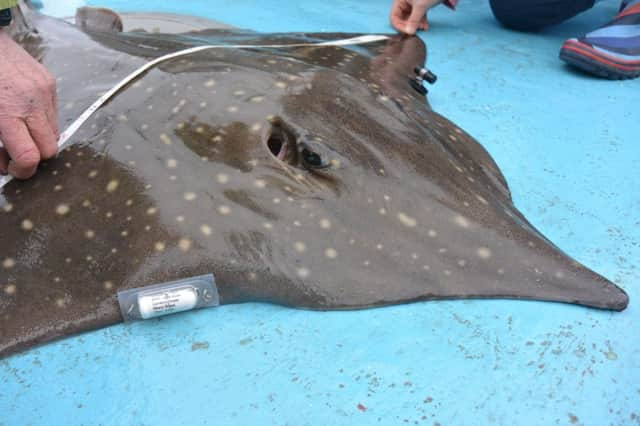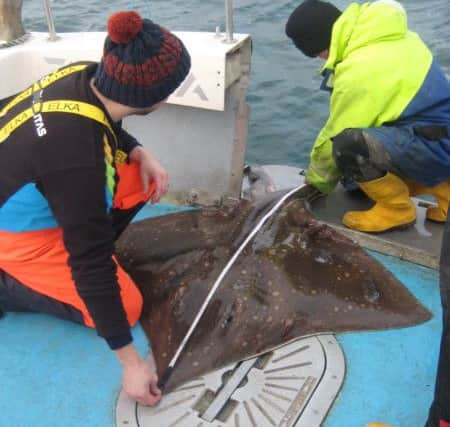Rare sharks and skates tagged in Argyll


The common skate and the small spurdog shark are two of the country’s most endangered fish.
Now hi-tech tracking technology is being used so experts can study the habits of individuals found in a special conservation site on the west coast.
Advertisement
Hide AdAdvertisement
Hide AdMarine biologists from government agencies Scottish Natural Heritage (SNH) and Marine Scotland Science (MSS), assisted by local creel fishermen and anglers, are carrying out the research to gain deeper insights into how the vulnerable species use the recently designated Argyll marine protected area (MPA).


The fish are caught, fitted with the tags and photographed for future identification before being quickly released back into the sea. DNA samples are also being collected for analysis.
The MPA covering Loch Sunart to the Sound of Jura was established to help protect the common skate, the world’s largest skate species.
The ‘winged’ fish, which are related to sharks, can grow up to two metres across and three metres long.
The team has already fitted tags to 40 skates caught in the area, the largest of which weighed in at 98kg – more than 15 stone.


The area is also a hotspot for spurdog, sometimes known as spiny dogfish, a small shark that grows up to 1.5 metres long.
Numbers of the species have fallen dramatically to around five per cent of previous levels.
Eight spurdog have been tagged so far in Argyll, with more planned in the weeks ahead.
Advertisement
Hide AdAdvertisement
Hide AdBoth species were once common in Scottish waters but have suffered significant declines in recent years.
They are now considered critically endangered and are included on Scotland’s list of Priority Marine Features for conservation action.
Sharks and rays have no bones, with skeletons made out of cartilage.
Skates are an ancient group of fish that first appeared in fossil records about 150 million years ago.
The latest figures suggest the UK spurdog population has declined by 95 per cent.
Dr Jane Dodd, project manager for SNH, said: “We’re really lucky in Scotland to have a wonderful range of wildlife living in our seas.
“Previous studies have shown that common skate are resident in the waters off Oban in significant numbers, and the MPA was designated for their protection in 2014.
“By tracking skate in the MPA we aim to better understand how they use the area throughout the year, which will help us to make sure that the management of the site is appropriate.”
Advertisement
Hide AdAdvertisement
Hide AdTwo types of tags are being used in the project. Acoustic tags will communicate with receivers positioned in the Sound of Mull, the Firth of Lorn, Loch Linnhe, the Lynn of Lorn and Loch Etive, recording each time an individual fish passes within range.
Some of the fish are also fitted with Data Storage Tags (DSTs), which record the depth and water temperature every two minutes and provide details about where the fish are spending their time.
Spurdog are generally thought to be a migratory species, travelling over large distances. However, research has shown that some remain in local waters throughout winter.
Dr James Thorburn, MSS Fish Tracking Officer, said: “There is some evidence that spurdog breed in Loch Etive.
“The tagging work will improve our understanding about the number of fish that move in and out of the loch, or remain there year-round.”
The equipment used in the project is also providing opportunities to study other species.
Marine Scotland has tagged salmon smolts leaving the rivers Lochy and Awe that will be detected by the same receivers.
The Scottish Association for Marine Science is also monitoring harbour porpoise clicks with equipment attached to some of the receiver moorings.